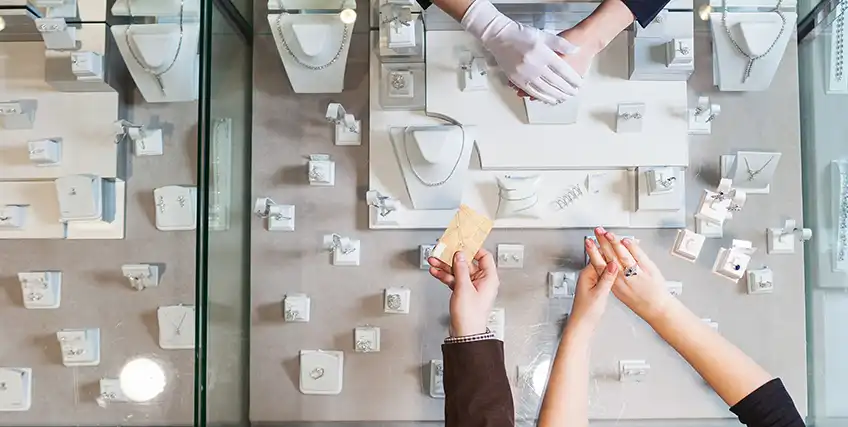Start a Small Jewelry Business
March 25, 2025 | Last Updated on: March 26, 2025

Starting your own jewelry business can be both financially and personally rewarding. This guide will walk you through every step of the journey, from crafting a business plan and defining your unique selling proposition to securing financing and building a thriving brand. Whether you're passionate about crafting handmade jewelry or curating fine jewelry collections, this article offers insights to help you achieve your entrepreneurial dreams.
Crafting a Solid Business Plan
Every successful jewelry business starts with a well-crafted business plan. This article serves as your roadmap, outlining your goals, strategies, and financial projections for your small jewelry business. To ensure a comprehensive approach that addresses potential challenges and solutions, utilize online templates and resources like the SBA's Business Plan Tool.
This is the time to choose a business name and solidify your brand identity, laying the foundation for your small jewelry business. Your business plan should articulate your business concept and goals, including your plans for crafting or curating jewelry designs. It should also detail your target market, including those seeking high-quality pieces for special occasions or those who prefer minimalist styles for everyday wear.
Don't forget to analyze your competition. Resources like data on retail sales from the U.S. Census Bureau can be helpful. Are there other businesses specializing in handmade jewelry? What are their unique selling propositions? What are the best sellers in your niche? This research will help you identify your competitive advantage. Finally, your business plan should outline your marketing and sales strategies, operations, and financial projections.
Defining Your Unique Selling Proposition
In a competitive jewelry market, your business plan must clearly define your value proposition. What sets your jewelry designs apart? Is it your craftsmanship, the use of sterling silver or specific gemstones, a focus on sustainability, or a commitment to ethical sourcing? Be sure to familiarize yourself with the Federal Trade Commission (FTC) guidelines on jewelry marketing to ensure accurate representation. Perhaps you're creating unique designs that stand out from the crowd or offering high-quality pieces at an accessible price point.
Your value proposition will be a key driver of your marketing efforts and will ultimately influence your sales. It's what will make customers choose you over other jewelry brands.
Curating Your Product Line
Your product line is the heart of your jewelry business. Define a clear theme – whether it's the material, style, or inspiration – to create a cohesive collection. Are you drawn to the elegance of silver jewelry? Will you offer birthstone pieces or incorporate unique gemstones?
Offer a diverse range of products to cater to different needs and preferences within your small jewelry business. This might include everyday essentials like hoops / hoop earrings and studs, statement pieces that showcase bold jewelry design, elegant fine jewelry for special occasions, and even personalized options like engraved initials or birthstone pendants. Consider incorporating current fashion trends, such as chokers or bangle bracelets, to keep your collection fresh and exciting.
When it comes to production in the jewelry industry, consider your options. You can find data on manufacturing and jewelry production trends from the Bureau of Labor Statistics (BLS).
Handcrafted jewelry offers a unique appeal and often commands a higher price point. Designing your own line and outsourcing production to a factory for jewelry-making allows for scalability and brand consistency. Drop-shipping provides an alternative model with lower startup costs but requires a strong marketing strategy.
Identifying Your Ideal Customer
For your small jewelry business to succeed, who is your customer? Who appreciates your jewelry designs? Define their demographics: age, gender, income, lifestyle, and interests. Are you catering to those seeking high-quality pieces for special occasions, or those who love minimalist styles? Understanding their preferences and buying habits shapes your successful marketing.
Choosing the Right Sales Channels
Choosing the right sales channels is essential for reaching your target audience. Will you focus on e-commerce, selling online through platforms like Etsy or Shopify? This offers wider reach and lower overhead costs. Or will you opt for a brick-and-mortar store, joining the ranks of successful small jewelry stores that offer personalized customer experiences and build trust, especially for high-end jewelry?
As an entrepreneur, you should consider a combination of sales channels. Participating in pop-up shops and craft fairs can be a great way to test new markets and introduce your brand. Social media platforms like TikTok and Instagram offer opportunities for brand building, direct sales, and engaging with your audience.
Analyzing Your Competition
Thorough competitor analysis is essential. Research your main competitors by analyzing their product lines, pricing, marketing strategies, and strengths and weaknesses. Are there other businesses specializing in handmade jewelry? What are their unique selling propositions? This research will help you identify your competitive advantage and develop strategies to stand out in the market.
Projecting Costs and Managing Finances
Accurately projecting costs is crucial for profitability. The IRS provides resources for small business tax information to help with this process. Factor in all expenses, including materials, labor, overhead, marketing, packaging, and shipping. Don't overlook hidden costs like your time spent on administrative tasks. A detailed cost analysis will help you determine pricing, assess profitability, and make informed business decisions.
Identifying Reliable Suppliers
Building strong relationships with reliable suppliers is essential for ensuring the quality and timely delivery of your jewelry components or finished products. If you're crafting handmade jewelry, research suppliers for metals, gemstones, beads, and findings. The Jewelers Vigilance Committee (JVC) offers ethical sourcing guidelines to help you choose responsible suppliers.
If you're designing your own line, partner with reputable jewelry manufacturers for small businesses who can produce high-quality pieces that align with your brand. If you're using a dropshipping model, carefully vet potential suppliers.
Forming Your Jewelry Business
With your business plan and funding secured, it's time to officially establish your jewelry business. This involves choosing the right legal structure and fulfilling all necessary legal requirements for your small jewelry business. Research any permits or licenses required to operate your business. Determine the best legal structure, such as an LLC, for liability protection. Finally, consider obtaining appropriate business insurance policies to mitigate potential risks.
Securing Initial Investment
There are several funding avenues available to small business owners looking for initial investments. Let's explore some of the most common options:
SBA Loans
The United States Small Business Administration (SBA) offers SBA Loans as one of its core programs for assisting small businesses. SBA loans are backed by the federal government and provided by lenders that have been pre-approved by the SBA.
This makes SBA loans more accessible to small businesses since lenders face less risk by lending through the program. It also allows SBA loans to have some of the most appealing interest rates available on the market.
One of the downsides of SBA loans is the application process, which is lengthy and very thorough. Borrowers and their businesses are carefully and diligently assessed, with applicants having to provide extensive information on the company, their business plan , their credit history, and more.
The most popular loan program that the SBA runs is its SBA 7(a) loan, which is a term loan that allows borrowers to access up to $5 million in funding. The loan comes with terms of up to 25 years, making it a long-term financing option for many borrowers.
Term Loans
Term loans are a common resource for an initial small business loan. Term loans provide borrowers a fixed upfront sum that must then be paid back over a set period of time with interest. They can be acquired with both fixed and variable interest rates for a variety of different term lengths, giving borrowers options and flexibility.
Terms loans are offered by both brick-and-mortar lenders and alternative lenders. There are advantages and disadvantages to using both types of lenders.
Term loans offered by traditional banks are known to be very difficult to qualify for with very strict qualification requirements. They tend to have very long application processes that require business owners to submit a lot of documentation and fill out a lot of paperwork. This thorough process allows traditional banks to assess the risk of each borrower thoroughly. In turn, those that are able to qualify for term loans from traditional lenders are able to get some of the lowest interest rates available.
Term loans that are provided by alternative lenders are much easier to qualify for. They have far less stringent standards for borrowers, and their application processes are quick and often offered online. However, because the application process is much less thorough, it is harder for lenders to assess the risk of lending to each borrower. As a result, interest rates tend to be higher.
Lines of Credit
Lines of credit are a common financing resource for almost every type of business. Lines of credit remain open for many years at a time and then can be renewed or reapplied for. Once you have a line of credit, you can borrow money from it at any time up to the limit set by the lender. Then, once you repay what you have borrowed plus any associated interest, you can borrow from the line again.
Lines of credit are great because they are a quick and easy resource for cash, making them ideal for shoring up cash flow in an emergency and short-term financing of smaller purchases. However, they are not ideal for large, long-term financing since their rates are variable and generally higher than you would get with a term loan. As such, it’s best to use them for short-term financing and gap funding while you find a longer-term solution for long-term borrowing.
Equipment Financing
Equipment financing is very popular for business owners that have to buy a lot of commercial-grade equipment to operate their company. With equipment financing, the equipment purchased with the funds serves as the collateral on the loan. This means that lenders have something they can use to salvage some of their funds if a borrower defaults. This makes equipment financing less risky for lenders, allowing more borrowers to qualify for them at lower interest rates than many other forms of financing.
Jewelry businesses, especially if you are making your own custom jewelry, often need expensive equipment to get started. Equipment financing could be a great resource for financing this.
Separating Your Finances
Once your business is formed, it's crucial to separate your business and personal finances. This protects your personal assets, simplifies accounting, and makes tax filing easier. Open a business bank account and get a business credit card to manage your business transactions.
Building a Strong Brand
With your business foundation in place, it's time to build your brand and start generating sales for your small jewelry business. Secure your suppliers and begin production, considering whether to offer pre-sales or launch marketing campaigns upon inventory arrival.
A strong brand is crucial for success. Develop a brand identity that reflects your values and resonates with your target audience. Craft a comprehensive marketing plan that utilizes various channels, including social media marketing, email marketing, and content marketing. Build a professional website or online store, with the goal of becoming the best online jewelry store in your niche, and provide detailed product details, including high-quality images, for each piece of jewelry. Offer excellent customer service to build trust and loyalty.
Selling Your Jewelry
With your brand established and marketing plan in motion, you're ready to start selling. Promote your products through various channels, highlighting the unique features and benefits of your jewelry designs. Offer promotions and discounts to attract new customers and encourage repeat business. Streamline the checkout process to make it easy and secure for customers to complete their purchases from your small jewelry business. Cultivate personal connections with your clientele, especially in a local market, to foster loyalty and encourage repeat business.
Growing Your Business
As your business grows, stay attuned to customer preferences and market trends. Regularly introduce new jewelry designs and expand your product lines to cater to evolving needs. Maintain an active online presence, engage with customers on social media, and seek customer feedback to enhance your small jewelry business. Attend industry events to stay updated on trends and network with other professionals.
Final Thoughts
Starting a small jewelry business, whether big or small, requires passion, dedication, and a well-defined strategy. By planning carefully, understanding your market, and building a strong brand, you can increase your chances of success in this dynamic and rewarding industry. Remember to stay focused on your unique selling proposition, offer high-quality products, provide excellent customer service, and adapt to evolving market trends to ensure the success of your small jewelry business.
FAQs about Small Jewelry Businesses
What funding options are available for starting a small jewelry business?
Several funding options exist for starting a jewelry business. SBA loans are popular for their favorable terms. Term loans from banks or alternative lenders offer a lump sum of cash. Lines of credit provide flexibility to borrow and repay as needed. Equipment financing helps you purchase equipment.
How can I secure funding to start my own jewelry business?
Create a strong business plan and research funding options like SBA loans, term loans , lines of credit, and equipment financing. Prepare a thorough loan application and seek guidance.
What are the costs involved in starting a jewelry business, and how can I fund them?
Costs include materials, equipment, marketing, and operations. Equipment financing covers equipment costs. SBA loans or term loans can fund startup costs. A line of credit helps manage ongoing expenses.
How can I finance the inventory for my small jewelry store?
SBA loans and term loans can help purchase inventory. Work with jewelry manufacturers offering flexible payment terms. For online stores, consider dropshipping to eliminate upfront inventory costs.
What are some tips for managing finances when starting a jewelry business?
Separate business and personal finances. Open a business bank account and get a business credit card. Create a budget, monitor cash flow, and consider accounting software. Seek advice from a financial advisor or explore other resources.




